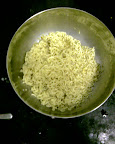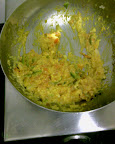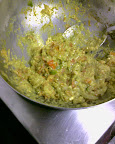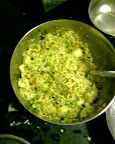These noodles are called Hitchhiker's Noodles because they are supposed to be for the Hitchhiker -- quick easy and cheap to make.
There are 4 main steps to making these noodles:
- Cook the noodles
- Cook the gravy
- Boil the the vegetables
- Mix the above, add sauce and garnish to serve
Let's discuss each one of them in detail:
- Cook the noodles: You may use any flavour noodles. I generally use Masala flavour Top Ramen or Maggi noodles.
- Cook the gravy: The gravy can be any gravy of your choice. I have used a tomato and egg based gravy, which is both tasty and healthy. Tomatoes and eggs are generally very widely and freely available(even on other planets!!!! ;-))
- Boil the vegetables: You may choose any combination of vegetables to add to the dish. I chose Cauliflower, Peas, and French Beans.
- Mix, sauce, garnish and serve: You need to properly mix up the individual constituents of the dish discussed above, and add sauce and mix again. Top off with your choice of garnish, and serve....
Now that we know the basic framework of the recipe, let's discuss the the recipe itself:
Cooking time: 42 minutes
Serves: 2
Ingredients:
- 1 packet(80g) Top Ramen Masala flavour noodles
- 1 1/2 Tbsp Butter(salted/unsalted)
- 1 onion, finely chopped
- 1 medium green capsicum, finely chopped
- 2 tomatoes, coarsely chopped
- 1 Tbsp Ginger paste
- 1 large Garlic clove, finely chopped
- 2 Pinch Asafoetida(Hing) powder
- 1 egg
- 1 Tbsp Pudina(Mint) paste
- 50g Cauliflower
- 40g Peas
- 50g French Beans
- Salt
- 1 tsp Soya Sauce(or to taste)
- 1 1/2 tbsp Tomato ketchup(or to taste)
- Fistful Coriander leaves for garnish
Procedure:
- Cook the Noodles as indicated on the packet. Add the flavouring when half the water has evaporated and mix well. Let some water remain after cooking so that the noodles can soak up the flavoured water. This will enhance the noodles' flavour.
- Remove from the heat and let them stand.

- Break the egg, and beat it for a few seconds till the white and yellow are mixed up well. Set aside.
- In a separate pan, add all the chopped up vegetables and put water so that all the vegetables are completely immersed in water. Add a teaspoon of salt(for faster cooking), and set aside to boil on a medium flame.

- In a separate pan, put the Butter, and when it is frothing hot, add the Hing and saute the onions till they are golden in colour.
- Add the Ginger paste and garlic and mix it up well.
- Add the finely chopped capsicum pieces till they are coated with butter.
- Add the tomato pieces, and salt to taste and cover with a lid. Cook on a low flame till the water in the tomatoes starts leaving it.
- Remove lid, and stir while cooking till most of the water from the tomatoes has evaporated.
- Now add the egg to the pan with the tomatoes. Keep stirring till the eggs are cooked. You may increase the flame to medium so that the egg gets cooked well, and the proteins coagulate. You will find that the egg will form a gravy with the moisture in the tomatoes. If we had used more eggs, we would have gotten scrambled eggs or bhurjee.

- Add the mint paste, and mix well. Turn off the flame, and set aside.

- Check if the vegetables have been boiled al dente. Once done, drain out all the water(and along with it, lots of the nutrients of the vegetables) and add it to the noodles.

- Now add the gravy we made to the noodles, and mix them all up well. Check the mixture. Add more salt if required.

- Add soya sauce, and tomato ketchup and mix it up well.
- Garnish with coriander leaves and serve in style ;-)

Variations:
- You may also add ajwain along with the Hing in the vaghaar(tadkaa) for a more aromatic flavour
- You may add more vegetables like carrots, cabbage. However, avoid using vegetables like cucumber, zucchini, sweet gourd(galka) since they give off lots of water, which will be lost when you drain off the water.
- Typically, each vegetable needs different amounts of time to cook properly. Peas cook fastest, followed by cauliflower, followed by french beans. So, expect your peas to be slightly over-cooked, your cauliflower to be cooked just right, and the french beans to be slightly under-cooked. It is the way it should be since this is a poor man's recipe. If you have the time, go ahead and cook them all separately.
I hope you enjoy cooking and experimenting with this recipe, and I wish you all the best :-)
2 comments:
nice recipe :-) one thing tho: even though this is a poor PERSON's (hehe) recipe, the veggies dont need to be cooked separately to ensure that they're all uniformly cooked (i.e. neither under- nor over-)... all you need to do is add the veggies that take longest to the water first (french beans).. then wait a bit.. a few min. later add those that take not-as-much time to cook (cauliflower), and just 1-2 minutes before you take the veggies off the stove, add the shortest cooking ones (peas/spinach etc) :-) voila !
hey, that's a really nice suggestion.... Thanks :-)
Post a Comment